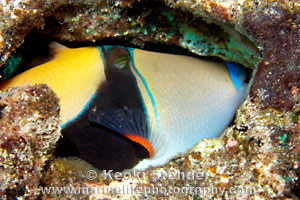If you enjoy snorkeling around Hawaii's reefs, you have probably encountered the state fish of Hawaii, the humuhumu nukunuku ā pua‘a also
known as the wedgetail triggerfish (formerly known as the reef or Picasso triggerfish) or Rhinecanthus rectangulus . The name is sometimes said to be longer than the actual fish! The Hawaiian word "humuhumu" means "to stitch together", perhaps relating to their geometric color patterns (1), while "nuku" means nose and "pua‘a" means pig, referring to their trademark pig-like snout. Thanks to the larger than average distance between their eyes and mouth, they are fit to feed on spiny invertebrates such as sea urchins without being hurt. The grunting sounds they create while feeding (2) or threatened resemble pigs as they they blow jets of water out
of their mouths into sand to locate tiny invertebrates such as shrimps and crabs.
 |
| Reef Triggerfish locking into a crevice. |
Their most distinguished feature is a double spine, or "trigger", which they can extend to lock themselves into crevices keeping them safe from predators. Known for his studies on reef fish ecology, Dr. E.S. Hobson found that their main survival technique relies on not just their trigger, but on other reef fishes as well. When large schools of fishes enter the area, the reef triggerfish will discretely crawl out of its crevice and not be noticed by other predators (shark, eels, etc.) This is a common behavior among reef fishes that find shelter in small spaces, such as slits and cracks in the reefs.
The humuhumu's compressed body facilitates a distinct type of swimming called Median Fin Propulsion (MPF). While a majority of fishes swim by creating a wave-like movement along their entire body, MPF swimming only involves the movement of the dorsal and anal fins keeping the rest of their body rigid. This unique technique allows for greater agility, stability for feeding, and flight from predators.
A professor at the Univeristy of Toronto, Rick Winterbottom, performed studies in 1974 which showed only two muscles in their fin rays. Whereas, Dr. Laurie Sorenson, a researcher under Louisiana State University discovered that reef triggerfish have developed 2 more muscles in their fins in the last 40 years alone. Her main focus was on their movement abilities and anatomy, coming across this discovery while working with the Hawaii Pacific University. The efficient MPF swimming and fast development of fin muscles demonstrate a quick evolutionary scale for a single species.
 |
| Reef Triggerfish with its trigger exposed. |
Coffey's work reflects a study done back in 1968 where researchers found that the pectoral fin drumming sounds were correlated with stressful interactions. These sounds imparticular were created when the reef triggerfish was being held underwater or in the air, while confronting an intruder, or when being chased. This may mean that humuhumus produce sounds to startle predators and the drumming action is another survival mechanism to compensate for them being a relatively slow-moving species.
There's a lot more to the Humuhumu nukunuku ā pua‘a than just being Hawaii's state fish! Hopefully, in the near future we will read about Coffey's results and gain a deeper understanding on their means of communication.
Written by Nikki Estrada and Casey Ching
Resources:
Pers. Comm. Bethany Coffey
Hoover, John P. The Ultimate Guide to Hawaiian Reef Fishes Sea Turtles, Dolphins, Whales, and Seals. Hono lulu: Mutual Pub., 2008. Print.
Pers. Comm. Bethany Coffey
Hoover, John P. The Ultimate Guide to Hawaiian Reef Fishes Sea Turtles, Dolphins, Whales, and Seals. Hono lulu: Mutual Pub., 2008. Print.
Waikiki Aquarium (2015) "Reef Triggerfish" (online) available at: http://www.waikikiaquarium.org/experience/animal-guide/fishes/triggerfishes/reef-riggerfish/
(accessed 2 Dec 2015)
Laurie Sorenson(2007)Examining morphological characteristics of triggerfish: a three-dimensional reconstruction of skeletal and muscular features of Rhinecanthus Rectangulus.
E.S Hobson (1972) Activity of Hawaiian Reef fishes during the evening and morning transitions between daylight and darkness.
M.Salmon, H.E. Winn,N. Sorgente (1968) Sound Production and Associated Behavior in Triggerfishes


No comments:
Post a Comment